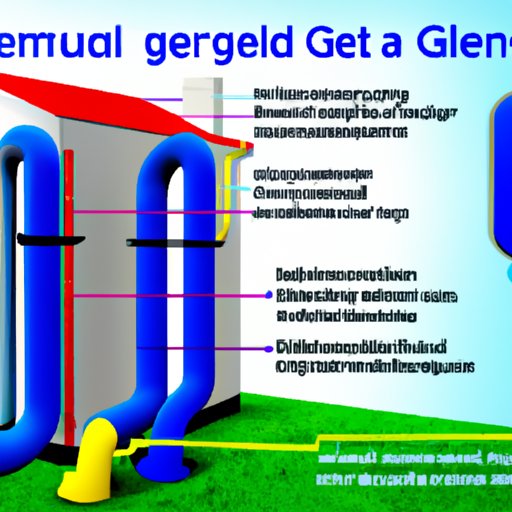Introduction
When it comes to heating and cooling our homes, we want a reliable, efficient, and cost-effective solution. Geothermal heating and cooling has emerged as one of the most popular options for people looking for an eco-friendly and efficient way to heat and cool their homes. But what exactly is geothermal heating and cooling, and how does it work? This article will explore the science behind geothermal heating and cooling, the types of geothermal systems available, and the advantages and disadvantages of using geothermal energy.
Exploring the Science Behind Geothermal Heating and Cooling
Geothermal heating and cooling is a process that uses the natural temperature of the earth to heat or cool a building. It works by transferring heat from the ground into a building in winter and vice versa in summer. The process is based on the fact that the temperature below the surface of the earth remains relatively constant throughout the year, regardless of air temperature.
The process of geothermal heating and cooling relies on a series of underground pipes, known as “loops”, which are filled with a water/antifreeze mixture. During the winter months, these loops absorb heat from the ground and transfer it into the building, while during the summer months, they absorb heat from the building and transfer it back into the ground. The heat exchanger then transfers the heat between the pipes and the indoor environment, providing a comfortable and efficient heating and cooling system.

A Guide to Understanding Geothermal Heating and Cooling Systems
Geothermal heating and cooling systems consist of four main components: the ground loop, the heat pump, the air handler, and the thermostat. The ground loop is a series of underground pipes filled with a water/antifreeze mixture that absorbs heat from the ground and transfers it into the building. The heat pump is responsible for transferring heat between the ground loop and the indoor environment. The air handler distributes warm or cool air throughout the building, depending on the season. Finally, the thermostat controls the temperature of the building.
There are two types of geothermal heating and cooling systems: open-loop systems and closed-loop systems. Open-loop systems use groundwater to heat and cool the building, while closed-loop systems rely on a network of underground pipes filled with a water/antifreeze mixture. Both types of systems offer efficient and cost-effective heating and cooling solutions, but closed-loop systems are generally considered to be more energy-efficient and environmentally friendly.
The Pros and Cons of Geothermal Heating and Cooling
Geothermal heating and cooling offers many advantages over traditional heating and cooling systems. For starters, geothermal systems are much more energy-efficient than traditional systems, meaning they can save you money on your energy bills. Additionally, geothermal systems don’t require any fuel, such as oil or gas, so they don’t produce any harmful emissions. Finally, geothermal systems are incredibly reliable and require minimal maintenance.
However, there are some drawbacks to geothermal heating and cooling. The installation of a geothermal system can be expensive, and it requires a lot of space for the installation of the underground loops. Additionally, if you live in an area with shallow soil, you may not be able to install a geothermal system. Finally, geothermal systems require a large amount of electricity to run, which can increase your energy bills.

Geothermal Heating and Cooling: An Overview
If you’re considering installing a geothermal heating and cooling system, it’s important to consider the cost of installation. Installing a geothermal system typically costs more than installing a traditional heating and cooling system, but it can save you money in the long run due to its energy efficiency. Additionally, you may be eligible for tax credits or other incentives for installing a geothermal system. It’s also important to keep in mind that geothermal systems require regular maintenance to ensure optimal performance.
If you’d like to learn more about geothermal heating and cooling, there are plenty of resources available. Your local utility company may provide information about geothermal systems, and there are websites and books devoted to the topic. Additionally, your local HVAC contractor can provide information on the installation of a geothermal system and the best type of system for your needs.

How Geothermal Heating and Cooling Can Reduce Your Energy Bills
Installing a geothermal heating and cooling system can help you save money on your energy bills. To maximize your savings, it’s important to develop strategies for reducing your energy usage. For example, you can set your thermostat to a lower temperature in the winter and a higher temperature in the summer. Additionally, you can take steps to reduce air leaks in your home, such as sealing doors and windows, and you can invest in energy-efficient appliances.
It’s also important to perform regular maintenance on your geothermal system. Regularly inspect the system for signs of wear and tear, and clean or replace the air filters regularly. Additionally, you should check the system for leaks and make sure that all the parts are working properly. By following these tips, you can ensure that your geothermal system is running efficiently and helping you save money on your energy bills.
Conclusion
Geothermal heating and cooling is an eco-friendly and efficient way to heat and cool your home. By taking advantage of the natural temperature of the earth, geothermal systems can help you save money on your energy bills and reduce your carbon footprint. While the installation of a geothermal system can be expensive, the long-term savings and environmental benefits make it a worthwhile investment. With proper maintenance and energy-saving strategies, you can enjoy all the benefits that geothermal heating and cooling has to offer.


